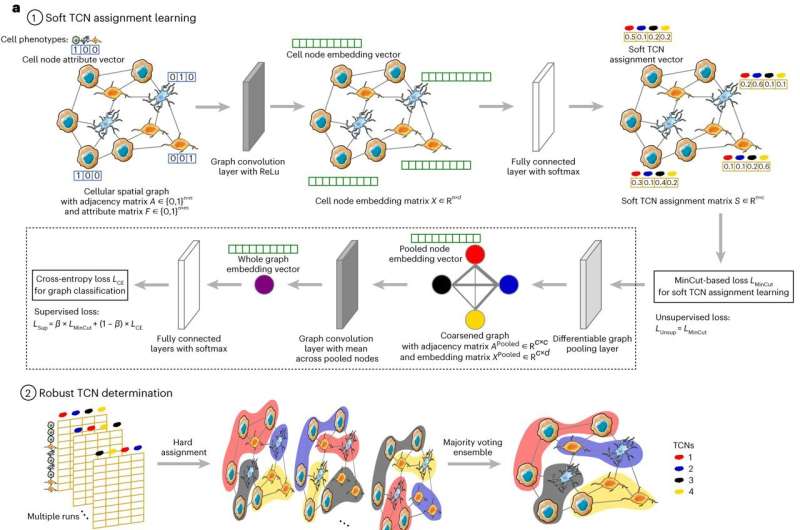This article has been reviewed according to Science X's editorial process and policies. Editors have highlighted the following attributes while ensuring the content's credibility:
fact-checked
peer-reviewed publication
trusted source
proofread
Researchers develop algorithm to determine how cellular 'neighborhoods' function in tissues

Researchers from Children's Hospital of Philadelphia (CHOP) have developed a new AI-powered algorithm to help understand how different cells organize themselves into particular tissues and communicate with one another. This new tool was tested on two types of cancer tissues to reveal how these "neighborhoods" of cells interact with one another to evade therapy, and more studies could reveal more information about the function of these cells in the tumor microenvironment.
The findings were published online in the journal Nature Methods.
To understand how different cells organize themselves to support the functions of a tissue, researchers proposed the concept of tissue cellular neighborhoods (TCNs) to describe functional units in which different, recurrent cell types work together to support specific tissue functions.
Across individuals, the functions of these TCNs would remain the same. However, translating the huge amount of information in spatial omics data into models and hypotheses that can be interpreted and tested by researchers requires advanced AI algorithms.
"It is very difficult to study the tissue microenvironment, how certain cells organize, behave and communicate with one another," said senior study author Kai Tan, Ph.D., an investigator in the Center for Childhood Cancer Research at CHOP and a professor in the Department of Pediatrics and the Perelman School of Medicine at the University of Pennsylvania.
"Until recent advances in so-called spatial omics technology, it was impossible to spatially characterize more than 100 proteins or hundreds or even thousands of genes across a piece of tissue, which might be home to hundreds of thousands of cells and their respective genes."
In this study, researchers developed the deep-learning-based CytoCommunity algorithm to identify TCNs based on cell identities of a tissue sample, their spatial distributions as well as patient clinical data, which can help researchers better understand how these neighborhoods of cells are organized and are associated with certain clinical outcomes.
In this study, tissue samples from breast and colorectal tumors were used because of a high volume of data available, enough to train the algorithm to identify TCNs associated with high-risk disease subtypes.
By using CytoCommunity for breast and colorectal cancer data, the algorithm revealed new fibroblast-enriched TCNs and granulocyte-enriched TCNs specific to high-risk breast cancer and colorectal cancer, respectively.
"Since we were able to prove the effectiveness of CytoCommunity, the next step is to apply this algorithm to both healthy and diseased tissue data generated by research consortia such as HuBMAP (Human BioMolecular Atlas Program) and HTAN (Human Tumor Atlas Network)," Tan said.
"For instance, using data from childhood cancers such as leukemia, neuroblastoma and high-grade gliomas, we hope to find tissue cellular neighborhoods that might be associated with responses to certain therapies and combine our findings with genetic data to help determine which genetic pathways may be involved at the cellular and molecular levels."
More information: Hu et al, Unsupervised and supervised discovery of tissue cellular neighborhoods from cell phenotypes, Nature Methods (2024). DOI: 10.1038/s41592-023-02124-2
Journal information: Nature Methods
Provided by Children's Hospital of Philadelphia





















